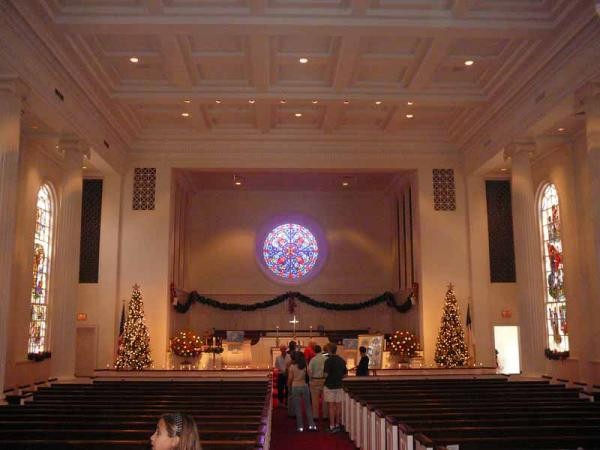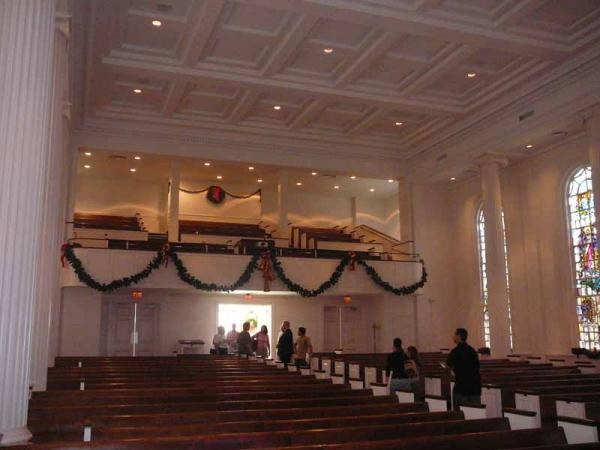First United Methodist Church
Introduction
Text-to-speech Audio
Images
Front of the present First United Methodist Church, constructed in 1968.

Inside First United Methodist Church.

Inside First United Methodist Church.

Backstory and Context
Text-to-speech Audio
This church building was erected in 1968, and became the sixth home of the congregation which dates back to Florida statehood. Originally, the church was founded in 1823, when the first Christian worship service was held four blocks from the building’s current location. Near the north bank of the St. Johns River, Reverend John Jerry, Methodist circuit rider, began to conduct worship services on the second floor of a dry goods store. In 1846, the present site was purchased, and a small chapel was built on the property. In 1858, it was dismantled to make room for a larger building that could accommodate a growing congregation.
During the Civil War, the sanctuary was used for daily prayer and worship services by Union troops. When the war ended, First United Methodist Church was the location where Florida Unionists held their convention and elected delegates to the Republican National Convention. The congregation built a new sanctuary at this location in 1890. The Great Fire of 1901 burned down a majority of Jacksonville, taking First United Methodist Church with it. The only remnants of the 1890 construction were two brick walls, which were then used in the building of yet another new sanctuary in 1902.
In 1922, an educational building that is still used today was erected, but not long after, the church suffered another fire. In October of 1930, it burned down once more, leaving just the memorials walls and windows spared. It was again rebuilt the following year, in 1931. The current and final structure was erected in 1968.
Due to the time period of First United Methodist Church’s founding, until 2018, the congregation was primarily white. Two miles west of the church, the Simpson Memorial United Methodist Church, which was constructed in 1884, had a primarily African American congregation. By 2018, both churches suffered from financial issues resulting from both operation and maintenance costs combined with declining memberships. Simpson Memorial needed $500,000 worth of repairs and mold remediation and suffered from termites, water leaks, and the need to complete previous renovation work. First United suffered from similar financial problems and their building also had mold issues that would require substantial funds to fix.
Beginning in the summer of 2017, First United Methodist Church pastor Reverend Tony Chance and Simpson Memorial United Methodist Church pastor Reverend Lawrence Q. Barriner, Sr. began discussing the possibility of having the two churches share one building to save both from financial ruin. Although the churches would not merge as one church, they would both operate out of the First United Methodist Church’s space, allowing them to split costs for things such as utility bills and repairs. Both pastors consulted Jay Therrel, the Jacksonville-area district superintendent for the United Methodist Church’s Florida Conference, before each bringing the idea to their members.
The two pastors formed a joint task force, and after enlisting five members from each church for help, they discussed details of sharing the space for two months. The group figured out how to separate worship, Sunday school, Bible study, choir practices, and kitchen use. They also had to figure out how to accommodate the Simpson Memorial electric organs and drums, since First United’s chancel area had a pipe organ. Eventually, each church organized two town meetings to inform the congregations. On April 8, they had a joint worship service to celebrate their new relationship.
Sources
- Our History, First UMC Jacksonville. Accessed October 27th 2020. https://www.firstumcjax.org/about-us.
- First - Jacksonville, The Florida Conference of UMC. Accessed October 27th 2020. https://www.flumc.org/churchdetail/638039.
- History, United Methodist Church. Accessed October 27th 2020. https://www.umc.org/en/who-we-are/history.
- Cravey, Beth Reese. Jacksonville churches, 1 Black, 1 white, to share space: ‘We all worship the same Christ’, The Florida-Times Union. March 31st 2018. Accessed October 27th 2020. https://www.jacksonville.com/news/20180331/jacksonville-churches-1-Black-1-white-to-share-space-we-all-worship-same-christ.
- 2007 Downtown Historic Church Tour, Metro Jacksonville. December 11th 2007. Accessed October 27th 2020. https://www.metrojacksonville.com/article/2007-dec-downtown-historic-church-tour.
https://www.flumc.org/churchdetail/638039
https://www.metrojacksonville.com/article/2007-dec-downtown-historic-church-tour
https://www.metrojacksonville.com/article/2007-dec-downtown-historic-church-tour
